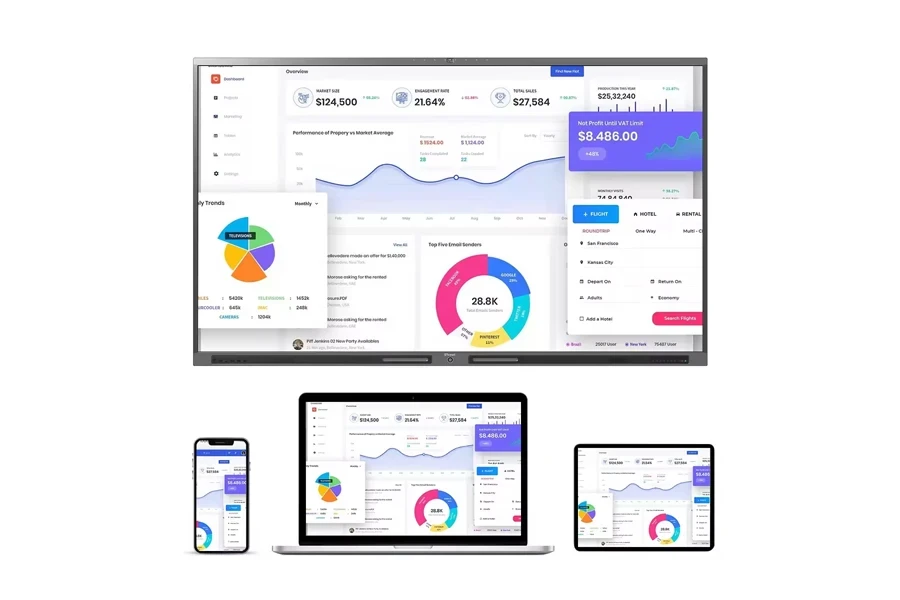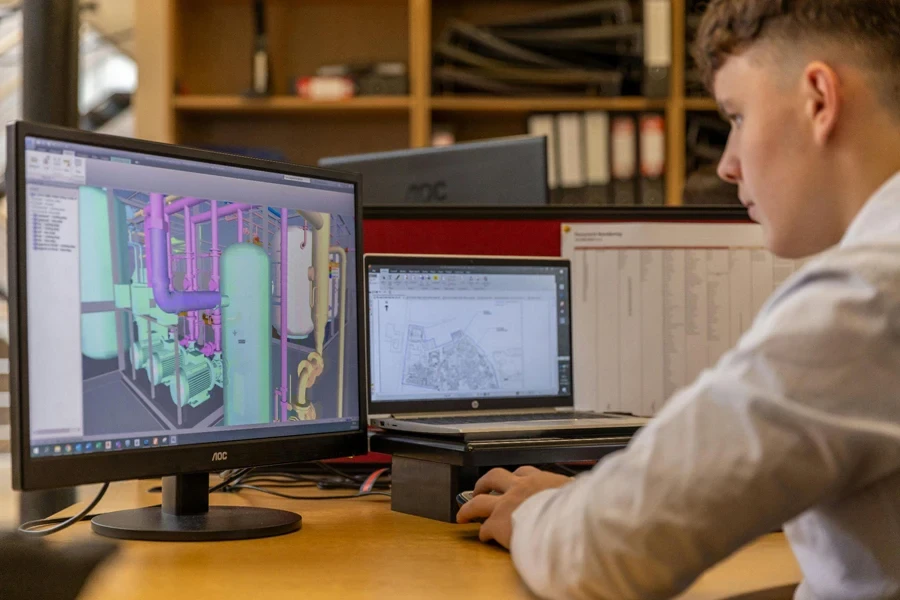Smart displays have become pivotal components in the evolving landscape of digital home technology. These devices, integrating voice assistance and touchscreen functionality, offer unprecedented control over home and office environments. From managing smart home devices to facilitating remote meetings and personal entertainment, smart displays are reshaping interactions within spaces where technology and daily life converge. Their ability to streamline complex tasks and enhance connectivity makes them indispensable for modern setups, pushing the boundaries of what integrated technology can achieve in personal and professional domains.
Table of Contents
1. Exploring the spectrum of smart displays
2. Insights into the 2024 smart display market
3. Key Considerations in Selecting the Right Smart Displays
4. Spotlight on 2024’s top smart display models
Exploring the spectrum of smart displays

The marketplace for smart displays reveals a diverse array of devices, each designed to cater to specific needs and environments. From compact units suitable for tight spaces to elaborate setups that command an entire room, the variety ensures that there is a smart display to match any requirement. High-end models often double as central hubs for home automation, allowing seamless control over other smart devices, from lighting and security systems to thermostats and entertainment units. These advanced models are not only tools for information and communication but also central command points that enhance the efficiency and convenience of technology-integrated spaces.
Varieties of smart displays: The classification of smart displays ranges from basic units that provide fundamental functionalities like time display and basic voice commands to sophisticated models that offer full-scale integration with extensive home automation systems. Entry-level smart displays are typically chosen for their affordability and straightforward utility, often employed in less demanding scenarios such as single-room setups or small apartments. On the other end of the spectrum, premium smart displays serve as the backbone of a connected home, offering robust support for a wide array of smart devices and high-level tasks that demand greater processing power and more refined interaction capabilities.
Functional capabilities explored: Central to the appeal of smart displays are their functional capabilities that dramatically enhance user interaction within a digital ecosystem. At their core, these devices leverage voice assistant technology to offer hands-free operation, which can range from simple commands like setting reminders and playing music to more complex directives involving smart home devices and online shopping. Moreover, with the incorporation of high-quality screens, smart displays facilitate video streaming, video conferencing, and real-time visual feedback from connected security devices, adding layers of functionality that extend well beyond traditional voice interaction. The integration of smart displays into home and office environments not only streamlines management of daily tasks but also enriches the user’s ability to interact with the surrounding digital landscape efficiently.
Insights into the 2024 smart display market

The 2024 smart display market is marked by rapid technological advancements and increasing consumer adoption, driven by enhanced connectivity and integration capabilities. As smart homes and offices become more prevalent, the demand for smart displays that offer robust functionality and seamless integration with other smart devices continues to grow. The trend is towards devices that not only streamline everyday tasks but also enhance the interactive experience through superior display and sound quality. Experts currently value the smart display market at US$ 3.74 billion in 2024, and they expect it to reach US $13.03 billion by 2029. They estimate this boost will happen at a 28.40% compound annual growth rate (CAGR) from 2024 to 2029.
Market dynamics and growth projections: The trajectory of the smart display market in 2024 shows significant growth, fueled by consumer interest in more interactive and connected living and working environments. Market research indicates a strong trend towards displays that offer higher resolution, adaptive displays that respond to environmental conditions, and those with AI capabilities that personalize user interactions. Projections suggest that the market for smart displays will see a compound annual growth rate of over 25% in the next five years, emphasizing the increasing importance of these devices in both residential and commercial spaces.
Who’s who in smart displays: The competitive landscape in the smart display sector is dominated by major technology firms that continuously innovate to capture consumer interest. Companies like Google and Amazon lead the market with their integrated ecosystems that offer users a seamless experience across multiple devices. These giants are followed closely by other tech companies that specialize in enhancing specific aspects of the smart display, such as privacy, energy efficiency, and user interface design. Strategic partnerships between tech companies and home appliance manufacturers are also shaping the market, creating more integrated smart home solutions that promise ease of use and increased functionality. These collaborations are pivotal in driving forward the innovation that characterizes the current market dynamics.
This detailed analysis of the market dynamics and key players provides a comprehensive overview of the smart display landscape in 2024, highlighting the growth prospects and the strategic moves by major players that are defining the future of home and office automation.
Key Considerations in Selecting the Right Smart Displays
Selecting the right smart displays involves evaluating several key features that determine their effectiveness in smart ecosystems. These include not only basic functionality like display quality and sound but also how well these devices integrate with existing technologies, their user-centric features, and the security measures they employ.
Harmonizing with Smart Ecosystems: Smart displays must excel in seamless integration with a variety of devices and platforms, making them central to the usability of smart home or office ecosystems. For instance, compatibility with major smart home standards like Zigbee, Z-Wave, or Apple’s HomeKit can significantly influence the decision-making process. A smart display that supports multiple standards is more likely to function smoothly within diverse technological environments, thus enhancing user experience by allowing control over various devices from a single point. For example, the Google Nest Hub Max uses Thread and Wi-Fi for connectivity, which ensures it can interact seamlessly with numerous smart devices without the need for additional hubs.
Evaluating Display and Sound Excellence: The quality of both display and sound is paramount, as these are the primary interfaces through which users interact with the device. Displays should offer high resolution for sharp, clear images and adaptable brightness settings to suit different lighting conditions, crucial for applications like video conferencing or media consumption. Sound quality is equally important; smart displays should have a well-balanced audio system that can handle voice commands even in noisy environments. Modern smart displays, like the Amazon Echo Show 10, are equipped with adaptive sound technology that optimizes audio output based on room acoustics, providing a richer sound experience that enhances voice interactions and multimedia playback.
Prioritizing Privacy and Security: In today’s digital age, the security and privacy features of smart displays are a top concern. Effective security protocols, such as two-factor authentication, end-to-end encryption for data transmission, and automatic security patches, are essential to protect user data from breaches. Privacy features should also include physical camera shutters and microphone mute buttons to provide users with control over their privacy. The Lenovo Smart Display, for example, comes equipped with a TrueBlock Privacy Shutter and microphone mute button to help secure personal interactions.
These detailed considerations are essential for professionals aiming to choose the right smart display. By focusing on these aspects, users can ensure they select a device that not only fits their immediate needs but also integrates smoothly into their broader smart technology landscape, offering enhanced functionality and security.
Spotlight on 2024’s top smart display models

As smart technology continues to integrate deeply into daily routines, the leading models of smart displays in 2024 highlight significant innovations that set them apart in the competitive market. These devices not only exemplify cutting-edge technology but also cater to the nuanced needs of a diverse user base, from professional settings to personal home use.
Detailed review of market leaders: The 2024 market for smart displays is characterized by significant advancements that push the boundaries of what these devices can do. Each leading model brings its own unique strengths to the table, catering to different aspects of home and professional use. Below are the top five models that have set the standard for performance, integration, and user-centric functionality.
Google Nest Hub (2nd Gen)
Google’s Nest Hub (2nd Gen) stands out for its well-integrated Google Assistant and seamless interaction with a wide range of connected devices. It features a 7-inch display and innovative sleep sensing technology, which uses motion and sound to analyze your sleep patterns without the need for a wearable device. This model is especially noted for its ambient EQ light sensor that adjusts the screen brightness and color to fit the room, making it less intrusive during night-time hours.
Amazon Echo Show 8 (2nd Gen)
The Amazon Echo Show 8 (2nd Gen) enhances the Alexa experience with an 8-inch HD screen and stereo sound system. It excels in communication capabilities, offering Alexa calling and messaging, along with a 13MP camera that pans and zooms during video calls to keep you centered in the frame. It integrates well with Amazon’s ecosystem, making it ideal for those who rely on Amazon’s suite of services and smart home devices.
Amazon Echo Show 10 (3rd Gen)
Known for its dynamic motion, the Echo Show 10 (3rd Gen) automatically rotates to face the user, ensuring that the display and camera are always oriented correctly during interactions. This feature is combined with a 10.1-inch HD screen that adapates its display color based on ambient lighting, providing comfort and enhanced visibility under varying lighting conditions.
Amazon Echo Show 15
As a larger option, the Echo Show 15 offers a 15.6-inch display that can be mounted on a wall or placed on a stand, serving as a digital hub for family organization. It features a built-in 5MP camera and acts as a central point for controlling smart home devices, displaying family calendars, and streaming media. Its customizable widgets and the ability to act as a full Fire TV device make it a versatile choice for any smart home.
Lenovo Smart Display
Lenovo’s Smart Display brings unique features such as a built-in projector for displaying content on larger surfaces, making it ideal for both entertainment and presentations. It supports Google Assistant and multiple smart home devices, offering a balanced mix of functionality and innovation with a clear display and robust sound system.
These models are leading the charge in the smart display market, each introducing features that cater to enhancing user interaction, home automation, and multimedia consumption. They reflect the ongoing evolution of smart home technology, each pushing the limits of what smart displays can accomplish in everyday scenarios.
Comparative insights: Comparing the top models, it becomes clear that while all aim to provide comprehensive smart home capabilities, each has distinct strengths. Google’s offerings are particularly strong in seamless integration with Google services and Android devices, making them ideal for users who are already heavily invested in the Google ecosystem. On the other hand, Amazon’s devices excel in robust home security features and a broader range of third-party app support, which might be more suitable for users looking for a versatile hub that can also function as a central control point for all smart home activities.
These insights into the leading smart display models of 2024 provide a clear picture of the market’s direction, emphasizing the importance of technical prowess and user-centric features in driving consumer choice. As the technology advances, the focus remains on enhancing connectivity, improving multimedia quality, and ensuring data privacy, catering to the increasing demand for smart displays that are both powerful and personalizable.
Conclusion
The exploration of smart displays in 2024 underscores their increasingly integral role in both professional and personal spheres. This guide has highlighted how strategic selection, based on integration capabilities, multimedia quality, and security features, is crucial for harnessing the full potential of these devices. As the market evolves, staying informed about the latest advancements and understanding the specific needs they address will ensure that investments in smart display technology are both effective and future-proof, enhancing connectivity and functionality in myriad settings.




